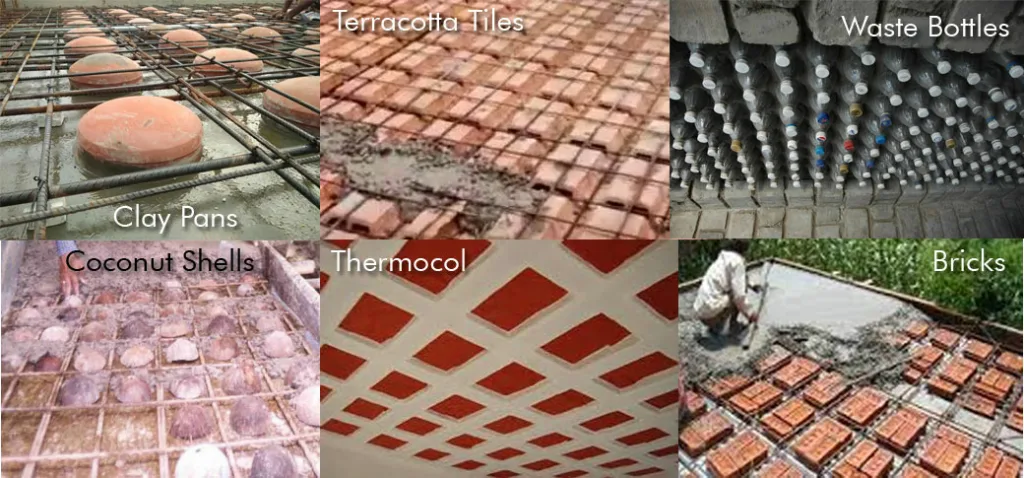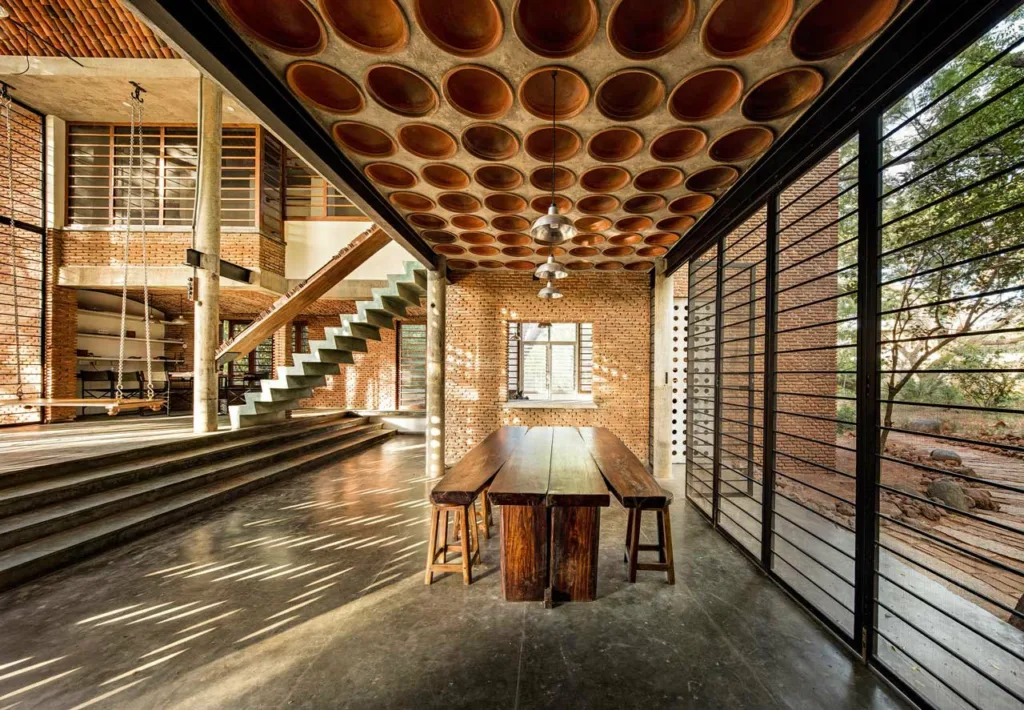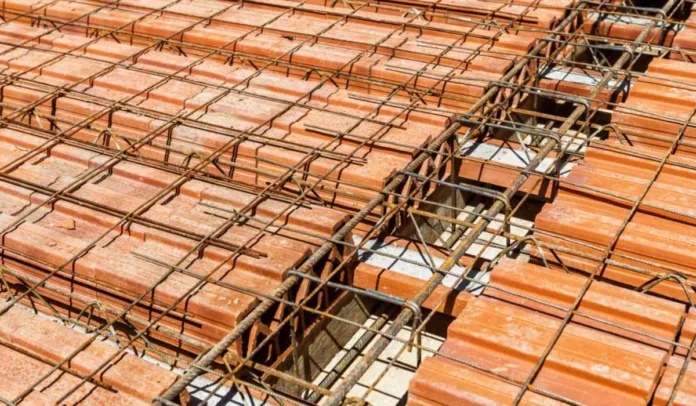Filler slabs are structural elements designed to minimise the amount of concrete used in construction while maintaining structural integrity. Instead of a solid mass, the slab incorporates voids or hollow spaces, typically in the form of blocks or ribs, reducing the overall weight and material requirements. Its construction involves placing a lightweight material, such as hollow clay tiles or expanded clay aggregates, between the structural members of a concrete slab of floor or a roof. This reduces the amount of concrete used, resulting in a lighter and more cost-effective construction.
Components of filler slabs
Filler slabs typically consist of the following components:
- Concrete: The main structural component provides strength and stability to the slab. It is usually used in the bottom and top layers of the slab.
- Filling Material: This is the material placed between the top and bottom layers of concrete to create voids and reduce the overall weight of the slab. Common filler materials include hollow clay tiles, expanded clay aggregates, or lightweight concrete blocks.
- Distribution Reinforcement: Steel reinforcement is often included within the filler material to enhance the load-carrying capacity and distribute loads effectively across the slab.
- Top Mesh Reinforcement: A layer of mesh reinforcement is placed on top of the filler material to improve the tensile strength of the slab and provide additional support.
- Bottom Mesh Reinforcement: Similar to the top mesh, a layer of reinforcement is placed at the bottom of the slab to enhance its structural integrity.
These components work together to create a lightweight yet structurally sound slab.

Advantages of filler slabs
- Weight Reduction: Filler slabs are lighter than traditional solid slabs, reducing the overall weight of the structure and allowing for more lightweight yet durable foundation design.
- Cost Efficiency: By using less concrete and steel, filler slabs offer cost savings in material and construction expenses, making them a financially viable option.
- Thermal Insulation: The voids created by filler materials provide natural insulation, helping regulate indoor temperatures and improve energy efficiency in buildings.
- Quick Construction: The simplicity of construction and reduced material usage can lead to faster and more straightforward construction processes compared to conventional slabs.
- Environmentally Friendly: Filler slabs contribute to sustainability by minimizing the environmental impact associated with excessive use of concrete and steel in construction.
- Flexibility in Design: Filler slabs allow for creative architectural designs due to their lighter weight and adaptable construction methods.
- Improved Seismic Performance: The reduced mass of filler slabs can enhance the seismic resistance of a structure, making it more resilient to earthquake forces.
- Adaptability to Local Materials: Filler slabs can be designed using locally available filler materials, promoting the use of regional resources and reducing dependency on imported materials.
Different types of materials used for filler slabs
Mangalore Tiles:
Mangalore tiles, known for their distinctive red hue and traditional design, are a popular choice for filler slabs. These terracotta tiles provide a natural and aesthetic appeal to constructions. Beyond their visual charm, they offer thermal insulation and contribute to a cooler interior environment, making them suitable for various architectural styles.
Clay Pans:
Clay pans, commonly used in construction, offer a sturdy and reliable option for filler slabs. Their natural composition and thermal properties make them effective in regulating indoor temperatures. The clay’s durability ensures long-term structural integrity, making clay pans a viable choice for sustainable and resilient construction projects.
Bricks:
Traditional bricks, when appropriately configured, can serve as effective filler materials in slabs. Their compressive strength and insulation properties contribute to the overall structural stability of the construction. Bricks also provide a cost-effective solution, especially when considering their widespread availability and ease of integration into construction practices.
Waste Bottles:
Repurposing waste bottles as filler materials not only addresses environmental concerns but also introduces a unique and sustainable approach to construction. When properly arranged and secured, waste bottles can contribute to the lightweight structure of filler slabs, promoting recycling and reducing the environmental impact of construction projects.
Coconut Shells:
Coconut shells, being lightweight and environmentally friendly, are utilized in filler slabs for their excellent thermal insulation properties. Their resistance to pests and fungi further enhances their appeal. Incorporating coconut shells into construction not only adds structural strength but also aligns with eco-conscious building practices.
Thermocol:
While not as conventional, Thermocol, or expanded polystyrene foam, serves as a lightweight and cost-effective filler material. Its insulating properties contribute to energy efficiency, and its ease of handling makes it a practical choice for specific construction applications. However, its usage may depend on local building regulations and considerations for long-term durability.
Stabilized Mud Blocks:
Stabilized mud blocks, composed of soil, sand, and stabilizers like cement, are employed as filler materials for their sustainability and thermal properties. These blocks are eco-friendly, cost-effective, and provide good insulation. Stabilized mud blocks contribute to a comfortable indoor environment while minimizing the environmental impact associated with traditional construction materials.
Terracotta Tiles:
Terracotta tiles, known for their natural earthy tones, are utilized as filler materials in slabs. These tiles offer a balance of aesthetic appeal and functional benefits, including thermal insulation. Their durability and resistance to weathering make them suitable for filler slabs, adding a touch of elegance to sustainable construction practices.
Expanded Clay Aggregates (LECA):
Used widely in filler slabs, expanded clay aggregates (LECA) provide a combination of high compressive strength and lightweight characteristics. They excel in thermal and sound insulation, making them suitable for various construction applications. Additionally, their resistance to fire and pests adds to their appeal.
Thermocol Beads:
Thermocol beads are a cost-effective option for filler slabs. Their lightweight nature makes them easy to handle, and they contribute to good insulation properties. Though not as structurally robust as some other options, their affordability and ease of use make them a practical choice in certain construction scenarios.
Recycled Plastic Elements:
In an effort to promote sustainability, recycled plastic elements are gaining popularity in filler slabs. These materials, often made from recycled plastics, offer both environmental benefits and lightweight construction. This presents a dual advantage of reducing plastic waste while providing an efficient building solution.
Hollow Blocks or Pottery Blocks:
Hollow blocks or pottery blocks are known for their lightweight yet durable composition. They provide good thermal insulation and are easy to handle and install. This makes them a versatile choice for filler slabs, particularly in regions where these materials are readily available.
Expanded Polystyrene (EPS):
Expanded Polystyrene (EPS) is valued for its lightweight properties and effective thermal insulation. Resistant to moisture, it is a reliable option for filler slabs. Its ability to be easily cut and shaped allows for flexibility in design and construction, contributing to its popularity in various building projects.
Pumice Aggregate:
Derived from lightweight volcanic rock, pumice aggregate offers a unique combination of low weight and good insulating properties. Its resistance to fire and chemicals enhances its suitability for filler slabs in diverse construction contexts.
Bamboo Mats:
Bamboo mats are a renewable and sustainable option for filler slabs. While providing decent strength and insulation, they stand out as an environmentally conscious choice. The cost-effectiveness of bamboo mats further contributes to their appeal in construction projects aiming for a balance between structural efficiency and eco-friendliness.

How to select the right materials for the filler slabs?
Selecting the right materials for filler slabs involves considering various factors to ensure optimal performance and cost-effectiveness. Here’s a step-by-step guide:
1. Structural Requirements:
– Assess the specific structural needs of your project. Different filler materials have varying load-bearing capacities and strengths.
2. Local Availability:
– Consider the availability of materials in your local area. Opt for options that are easily accessible to minimise transportation costs.
3. Cost Considerations:
– Evaluate the cost of materials, including installation and maintenance expenses. Balance the benefits of each material with your budget constraints.
4. Climate and Environmental Conditions:
– Account for the climate and environmental conditions of the construction site. Some materials may offer better resistance to moisture, pests, or extreme temperatures.
5. Insulation Requirements:
– Determine the level of thermal and sound insulation required. Choose materials that meet these insulation needs while staying within budget constraints.
6. Sustainability:
– Consider environmentally friendly options, such as recycled or renewable materials, to align with sustainable construction practices.
7. Ease of Installation:
– Evaluate the ease of handling and installation for each material. Some materials may require specialised skills or equipment, affecting overall construction efficiency.
8. Long-Term Durability:
– Assess the long-term durability of the materials under consideration. Factor in potential wear and tear, resistance to decay, and maintenance requirements.
9. Regulatory Compliance:
– Ensure that the selected materials comply with local building codes and regulations. This is crucial for the safety and legality of the construction project.
10. Consultation with Experts:
– Seek advice from architects, engineers, or construction professionals who have experience with filler slabs. Their expertise can help you make informed decisions based on the specific needs of your project.
By systematically evaluating these factors, you can make an informed decision on selecting the most suitable materials for filler slabs, balancing structural integrity, cost efficiency, and environmental considerations.

Application methods of filler slabs
1. Preparation:
– Ensure the formwork is properly set up and supported.
– Clean the formwork surface to remove any debris.
2. Placement of Filler Material:
– Place lightweight filler material (such as expanded clay aggregates or broken pieces of bricks) evenly across the formwork.
3. Binding Layer:
– Apply a thin binding layer of cement mortar over the filler material to hold it in place.
4. Reinforcement Placement:
– If required, place the reinforcement mesh or bars on top of the filler material. This enhances the slab’s strength.
5. Second Layer of Filler:
– Add a second layer of filler material on top of the binding layer. Ensure an even distribution.
6. Final Binding Layer:
– Apply another layer of cement mortar to bind the second layer of filler material and create a smooth surface.
7. Curing:
– Allow the filler slab to cure for the recommended time. This ensures the strength and durability of the structure.
8. Formwork Removal:
– After curing, carefully remove the formwork to reveal the finished filler slab.
Following these steps ensures a systematic and effective application of filler slabs, combining chosen materials with concrete to create a reliable and durable structural element in construction projects.
Conclusion
Filler slabs offer a lightweight and cost-effective solution for reducing the concrete volume in slabs. Their cost-effectiveness, coupled with enhanced thermal insulation properties, makes them a compelling choice for modern construction practices. As the industry continues to prioritise eco-friendly alternatives, filler slabs emerge as a promising and pragmatic option, offering a harmonious blend of structural integrity and environmental consciousness.

